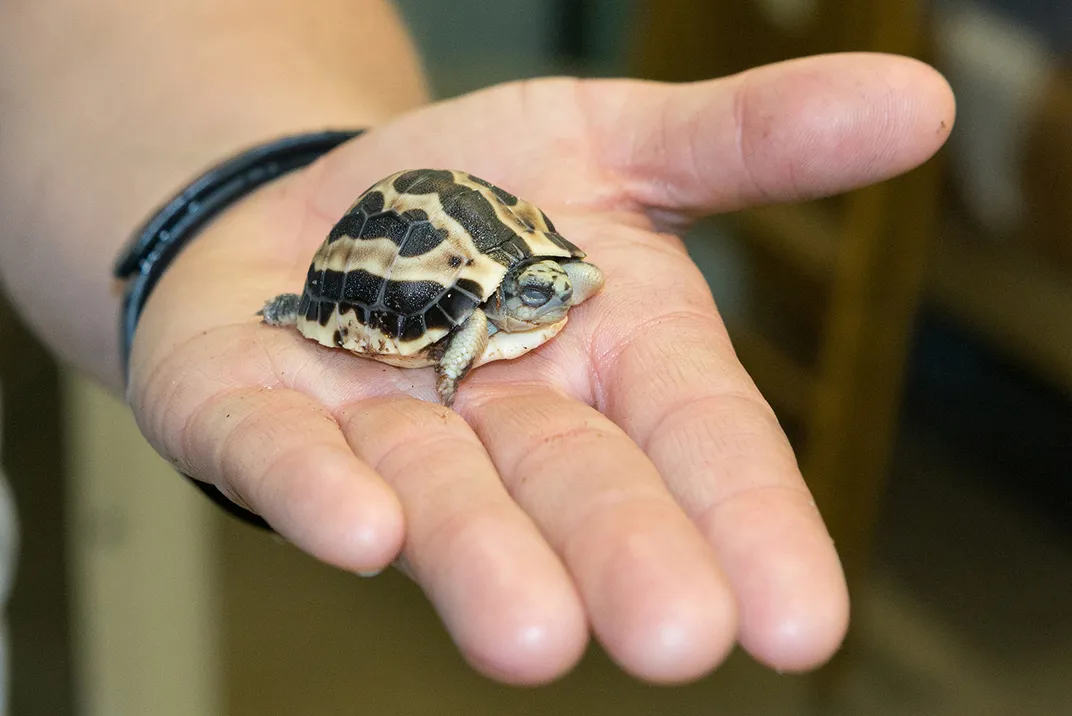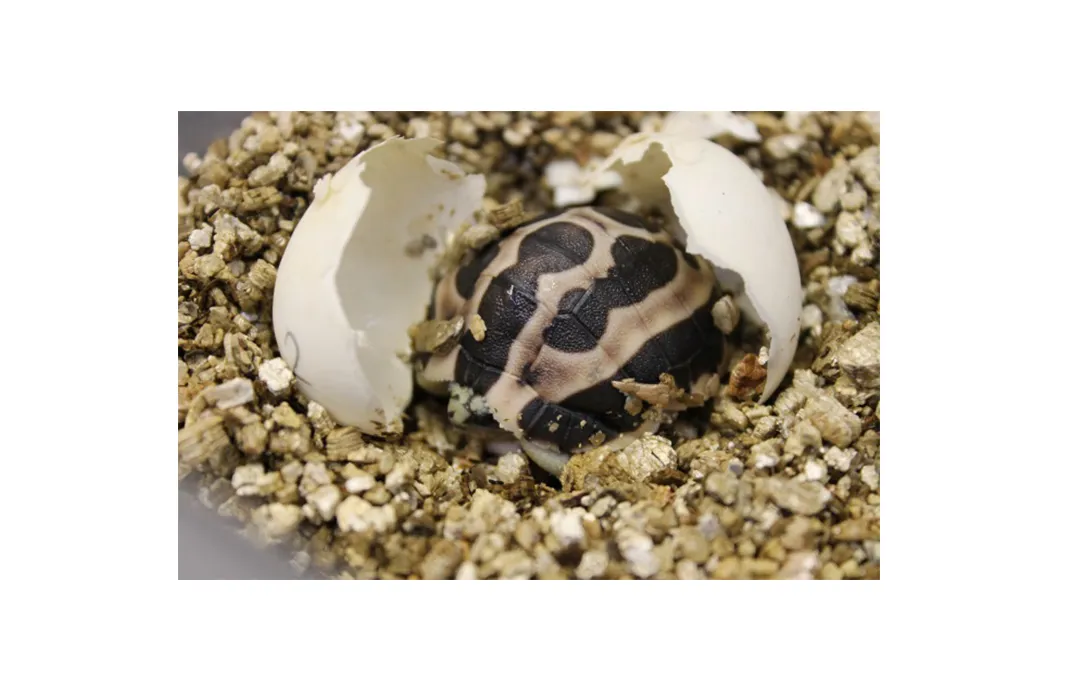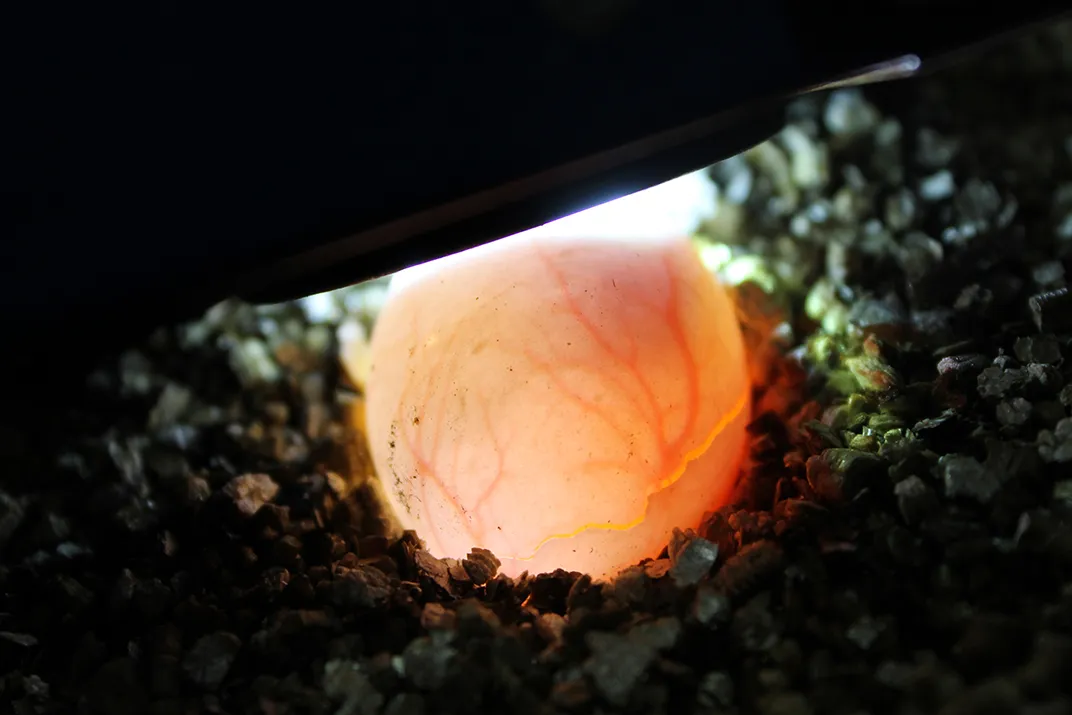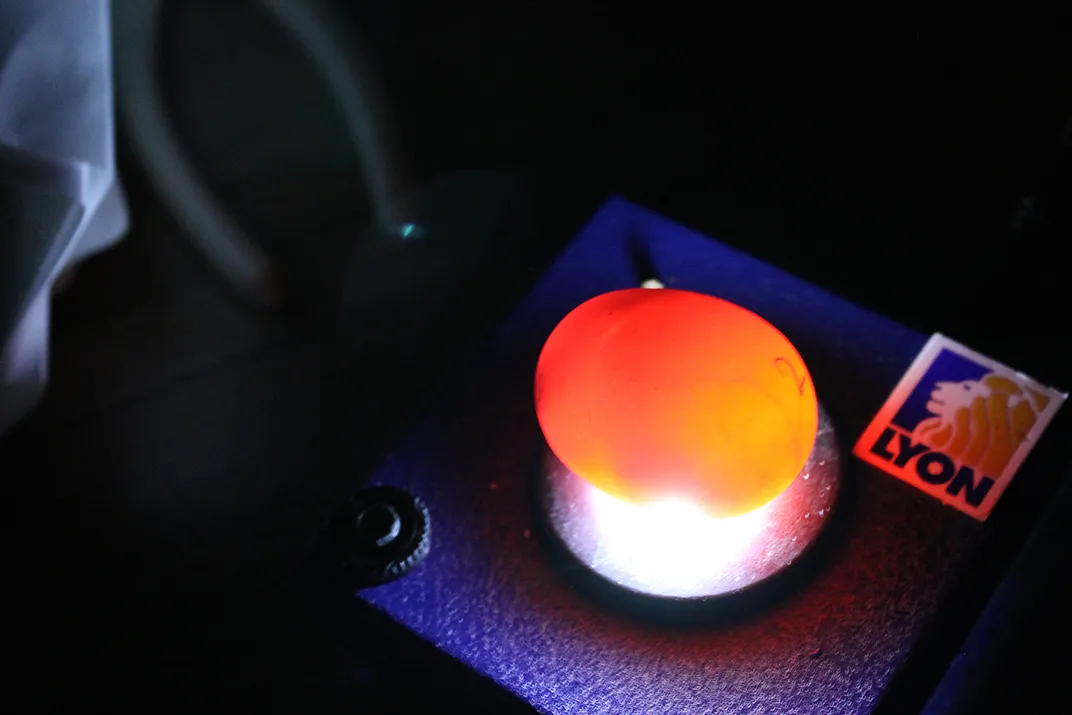UPDATE: Second Critically Endangered Tortoise Hatches from a Cracked Egg
To get the critically endangered Madagascar spider tortoises to breed successfully took both tenacity and a whole lot of luck
/https://tf-cmsv2-smithsonianmag-media.s3.amazonaws.com/filer/5e/36/5e36656b-02f7-47b0-8fb8-b41dc1e7e198/2015061002laurenaugustineweb.jpg)
UPDATE 6/15/2015: You might think a cracked oozing shell would spell the end for a developing reptile egg, especially one with a tricky incubation period and a rocky record for successful captive breeding. But the healthy baby spider tortoise that began pecking through its shell normally on June 8 is proof that a little glue and some tender loving care can go a long way.
Exactly four weeks earlier, the first of two eggs laid by the Smithsonian National Zoo’s new female spider tortoise hatched (see story below), and the Zoo announced its remarkable success in breeding this critically endangered species. This second hatchling is even more notable for the emergency efforts that the animal keepers took to keep it alive.
In April, as the egg warmed in an incubator, animal keepers noticed a small crack in the shell. After a few weeks of daily monitoring, the crack began to leak fluid and a blood vessel started poking through it. Zookeepers Robin Saunders and Lauren Augustine knew that if they did nothing, the developing turtle would die. So they came up with a plan. They sterilized a piece of gecko shell and glued it over the oozing wound, careful not to put pressure on the crack.
The procedure has been done with bird eggs before, but according to Matt Evans, a biologist at the Zoo's Reptile House, they had never heard of it being attempted in reptiles. The shell patch held, but as the tortoise continued to develop, there was no way to know if bacteria or another form of infection had entered the egg. Then on Monday, June 8, the baby tortoise began “pipping,” or using its special beak tooth to break through the shell. When it was fully hatched, keepers were relieved to see that the baby was healthy, but it wasn’t completely out of the woods yet.
The tiny tortoise hadn’t absorbed all the yolk from the sack still attached to its undercarriage. Young reptiles need the nutrition supplied by the yolk for their first few days of life, so Zoo staff kept the turtle in the incubator on a moist towel until all the yolk was absorbed. Now it’s a healthy, itty bitty spider tortoise ready to join the rest of the Zoo’s collection.
“I give a lot of credit to our keeper staff,” says Evans. “They knew this egg wasn’t going to make it, and they put their heads together and made sure they did whatever they could to. It really shows the care that goes into each little egg.”
###
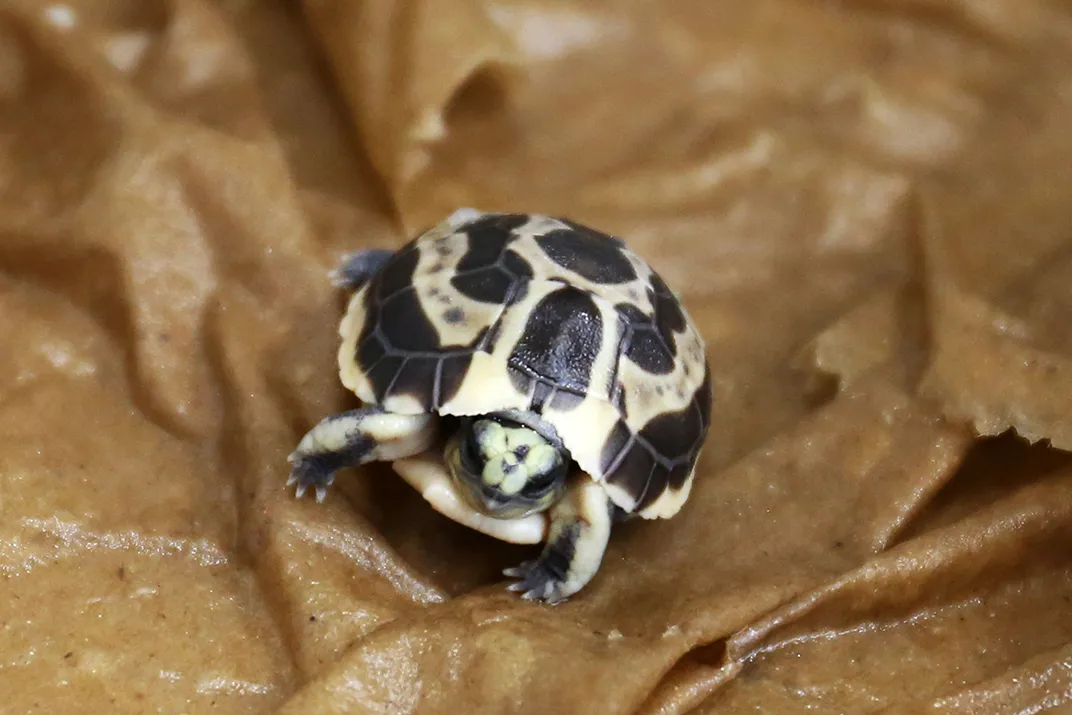
5/22/2015: Sometimes a change of scenery makes all the difference. The pair of critically endangered spider tortoises that arrived at the Smithsonian’s National Zoo in Washington, D.C., last June had been living together for 14 years in a Texas zoo and had never produced a viable hatchling. Then, on May 10 of this year, their first baby tortoise broke its way out of its shell, and the second one is expected any day.
“For these animals to have been transferred from Houston to the National Zoo and successfully produce a fertile egg, and it hatching, so quickly is pretty amazing,” says Mike Ogle, a curator at Knoxville Zoological Gardens in Tennessee, and an expert in spider tortoises.
Named for the golden spider web-like pattern on their shells, the tortoises are at risk of extinction in their native Madagascar, where they have declined by 80 percent since 1970. Researchers predict that the current population of 2 to 3 million individuals could disappear completely within the next 60 to 80 years. Not only are they threatened by habitat loss, but at four to five inches, they’re easy to transport and highly sought after for the illegal pet trade and the Asian food market.
Over the past decade-and-a-half, zoos and private breeders have been trying to figure out the magic combination of conditions necessary for breeding and incubating spider tortoises. Success rates have been notoriously low. Many zoos have never managed to produce a hatchling at all, so it’s quite remarkable that the National Zoo produced not just one, but has another on the way, and within less than a year of acquiring the pair.
Both the male and the female had been hatched and raised to adulthood in Madagascar and legally imported to the Houston Zoo in 2000. “Houston was just not doing well with this pair, and the National Zoo expressed an interest in breeding,” Ogle says. “So that’s why we decided to transfer them to Washington.”
Ogle is the breeding coordinator for the spider tortoise’s Species Survival Plan, a strategy established by the Association of Zoos and Aquariums to maintain a captive colony in case the species becomes extinct in the wild. Ogle is among the few animal keepers who managed to achieve a steady success rate in recent years, hatching more than a dozen last season. He can’t say why other breeders have been unable to replicate his success, but he was excited to learn that the National Zoo had hit the nail on the head on the first go.
“I think it comes down to the passion of the keeper staff,” Ogle says. “If they’re really into it, that of course will help your cause. Passion and caring, and giving a lot of different food items for a healthy, diverse diet.”
Beyond their enthusiasm, the keepers had to navigate a number of complex issues to breed the animals. What makes them so tricky is their unusually finicky 220 to 250 day incubation period. The eggs have to be heated then cooled, then heated again in a rigid routine requiring a vigilance that would rival that of any helicopter parent.
“With a reptile egg you typically wouldn’t incubate at 85 degrees for weeks and then all of a sudden drop the temperature to 60 degrees,” says Matt Evans, a biologist at the National Zoo’s Reptile House where the tortoises were bred and hatched. But that’s exactly what he and his team did. “Spider tortoises need what’s called a diapause, a pause in development triggered by change in temperature.”
Evans said he and the other keepers conducted an enormous amount of research before deciding how to incubate their tortoise eggs. “I talked with some people that I knew that had been successful with spider tortoises,” Evans says, “and what was fascinating was that almost every person we talked to did something different. Some said cool them first, others said warm them for 12 weeks first.”
Evans and his team embarked on a plan to gather and meticulously sift through data to determine the specific conditions in the tortoises' native Madagascar that produced results. “The best thing we can do when looking at animals in captivity that are typically difficult to breed or hatch is to study what happens in the wild,” he adds.
Female spider tortoises are believed to mate in the warm rainy season and lay one to four eggs, each spaced one month apart. Cooler, drier weather then sends the tortoises into brumation, the reptile version of hibernation. The cool season is also when their eggs go into diapause until warmer conditions return.
Each month from August to September 2014, the Zoo’s female tortoise laid an egg, but no one knew if the three eggs were fertile. After studying the spider tortoise’s natural history, Evans and his team decided to cool them to a lower temperature than other programs did and keep them cool longer. First, the team warmed the eggs to 80 degrees in an incubator, and then transferred them to a wine cooler, the appliance of choice for inducing diapauses. They dropped the temperature two degrees or so every day until it reached a chilly 60 degrees. After a period of weeks, they gradually warmed the eggs up again and transferred them back to the incubator for a gradual ride to a balmy 84 to 86 degrees.
Those were long, uncertain weeks during which the scientists had no idea if their efforts were working. If you shine a light through most reptile eggs after a few weeks of incubation, you’ll see veining where the embryo is attaching to the shell. Spider tortoise eggs look completely empty until well after they’ve been re-warmed. In the end, one of the Zoo’s three eggs was a dud, but the other two did exactly what they were supposed to do. Over the following weeks, within the eggs, two healthy baby tortoises began to develop.
“To be honest, we were all surprised it worked the first time,” Evans says. It could have been beginners’ luck, or it could be a sign that they’ve hit on something important. “Before we could make any kind of claim like that, it would have to be recreated next year,” Evans says. “But I think it’s a smart approach to look at how long these eggs are being cooled in the wild and the temperatures they’re being cooled to.”
Evans couldn’t give a specific date, but says the baby tortoises will be on exhibit in the reptile house soon.
/https://tf-cmsv2-smithsonianmag-media.s3.amazonaws.com/filer/4f/bd/4fbd412f-40ce-4a5f-a8ef-70b4671e393d/20150520198cpmweb.jpg)


